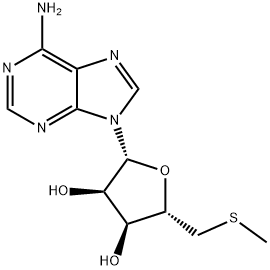中文同义词:
5-甲硫腺苷;5-脱氧-5-硫代甲基酰苷;5-脱氧-5-甲硫腺苷;5ˊ-脱氧-5ˊ-甲硫基腺苷;甲硫腺苷;5′-脱氧-5′-腺苷;5-脱氧-5-甲硫腺苷 (5-脱氧-5-硫代甲基酰苷、5ˊ-脱氧-5ˊ-甲硫基腺苷);甲硫腺苷对照品
英文名称:
5-DEOXY-5-METHYLTHIOADENOSINE
英文同义词:
2-(6-aminopurin-9-yl)-5-(methylsulfanylmethyl)oxolane-3,4-diol;7-(5-Methylthio-5-deoxy-D-ribofuranosyl)-7H-purine-6-amine;7-[Tetrahydro-3α,4α-dihydroxy-5β-(methylthiomethyl)furan-2-yl]-7H-purin-6-amine;5-S-Methyl-5-thioadesine;5-Deoxy-5-(methylthio)adenosine ,98%;1-(6-AMino-9H-purin;5-Deoxy(Methylthio)adenosine;NSC 335422
相关类别:
中药对照品;生物碱;化工原料;Biochemicals and Reagents;Nucleoside Analogs;Nucleosides, Nucleotides, Oligonucleotides
沸点
642.7±65.0 °C(Predicted)
密度
1.85±0.1 g/cm3(Predicted)
酸度系数(pKa)
13.10±0.70(Predicted)
生物活性
5-Methylthioadenosine 是由 S-腺苷酸产生的,有强效的抑制作用。
靶点
Human Endogenous Metabolite
Human Endogenous Metabolite
体外研究
5-Methylthioadenosine (MTA) can affect cellular processes in many ways. 5-Methylthioadenosine has been shown to influence numerous critical responses of the cell including regulation of gene expression, proliferation, differentiation and apoptosis. Although most of these responses have been observed at the pharmacological level, their specificity makes it tempting to speculate that endogenous 5-Methylthioadenosine could play a regulatory role in the cell. Finally, observations carried out in models of liver damage and cancer demonstrate a therapeutic potential for 5-Methylthioadenosine that deserves further consideration [1] .





